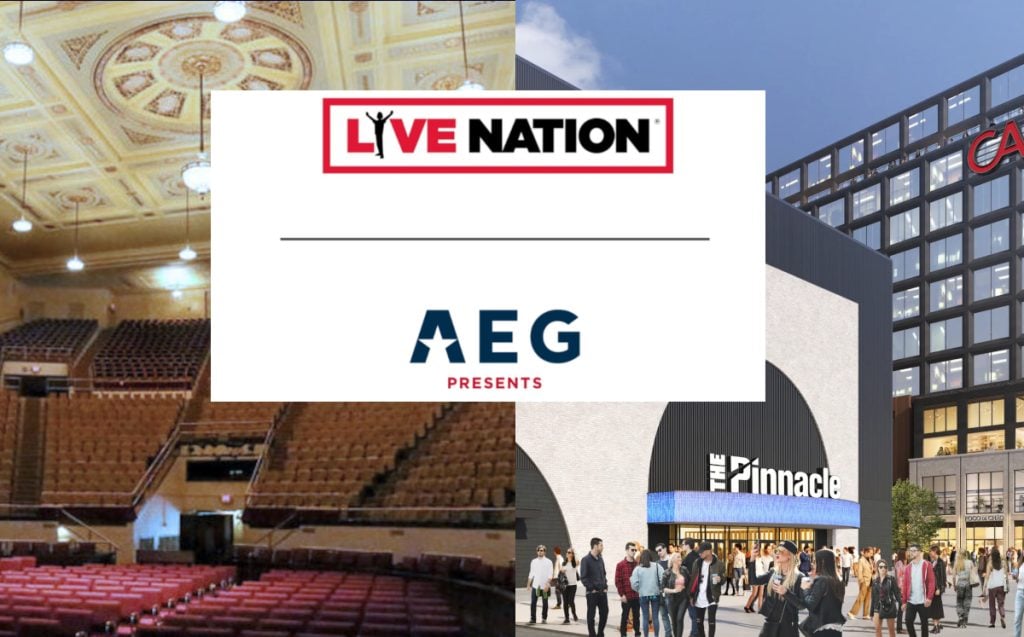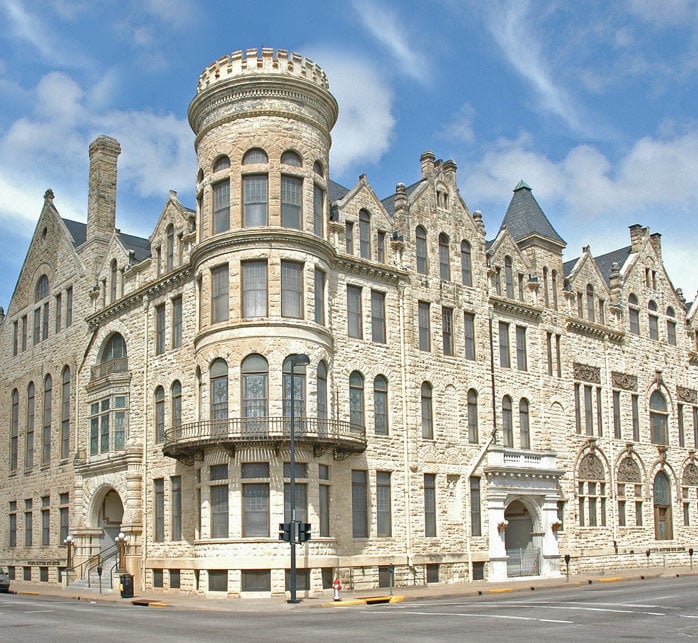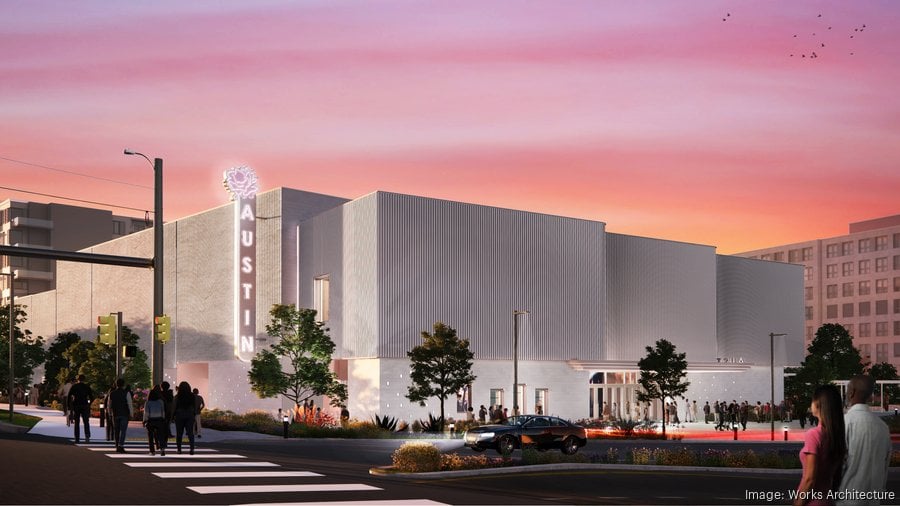AEG / Live Nation Now Coming for Music’s Mid-Sized Independent Venues

In 2017, a small company called Beaty Capital Group had an ambitious idea. In order to save some of the historic Masonic halls throughout the Midwest, they would begin buying these properties up, restoring them, and making them into live music venues. The concept took shape under the company name Temple Live.
Their first purchase was of a temple in Fort Smith, Arkansas originally built in 1928, and added to the National Registry of Historic Places in 1992. With an 1,100-capacity auditorium, it was the perfect mid-sized venue for the Arkansas town that needed one, and would make sure the historic building would not be subject to the wrecking ball.
Subsequently, similar historic Masonic temples were purchased in Cleveland, Ohio, Columbus, Ohio, Wichita, Kansas, and Peoria, Illinois. The Masonic Lodge in Columbus called The Athenaeum was built in 1899. The Masonic Auditorium on Euclid Ave. in Cleveland was originally purchased by Temple Live for $725,000, and they subsequently spent some $14 million renovating it, speaking to the commitment the company put into the project.

Over time, these concert venues became beloved and vital to both touring acts coming to town who might not stop if it weren’t for these mid-sized venues, and by locals who previously would complain how these acts would never stop in their town. But all that fell apart starting in early September when Temple Live venues shuttered with little notice, leaving bands scheduled to play in a lurch, and the future of these historic buildings uncertain.
“We determined it was best to be definitive so the decision was made to pull down the remaining shows,” said Lance Beaty, CEO of Beaty Capital Group. He blamed multiple factors for the company’s struggles, including lingering issues from the COVID-19 pandemic, and ticketing systems that disfavor independent promoters.
“We are simply an outsider in an insider’s business. No matter how much money you throw at it or how creative you think you are, if you’re not on the inside, you’re not in.”
This is the story many independent venue owners and promoters are telling all across the United States, and it’s about to get much worse. As Saving Country Music chronicled in August, important independent venues are shutting down left and right, from the Crystal Palace in Bakersfield, California, to Duke’s in Indianapolis, to the Coupland Dancehall in Texas (update pending).
Meanwhile, one of the catalysts for the catastrophic implosion in mid-sized independent venue ownership in the United States is about to make matters much worse. Live Nation has decided they’re investing some $1 billion in small clubs, mid-sized venues, and larger venues in 18 mid-sized markets across the United States. This means the company that already dominates much of live touring and venue booking in major cities is coming for other markets as well.
Some of the markets Live Nation says they’re coming to are:
Allentown, PA – Atlanta, GA – Birmingham, AL – Denver, CO – Indianapolis, IN – Memphis, TN – Milwaukee, WI – Nashville, TN – Orlando, FL – Portland, ME – Portland, OR – Pittsburgh, PA – Raleigh, NC – Richmond, VA – Riverside, MO – Seattle, WA – Shakopee, MN – Virginia Beach, VA
And LiveNation is not alone. America’s second-largest concert promoter, AEG, is enacting a similar strategy to corner the mid-sized market. This includes Nashville’s newest venue The Pinnacle (4,500 capacity), Atlanta’s The Eastern (2,300 capacity), Boston’s Roadrunner (3,500 capacity), Brooklyn’s Brooklyn Steel (1,800 capacity), and Denver’s Mission Ballroom (4,000 capacity).
Just this week, AEG revealed the architectural renderings, and broke ground for the new 4,000-capacity indoor entertainment venue they have planned for Austin, TX opening in early 2027 on Riverside Drive east of downtown, near where the rock venue Emo’s relocated.

“This new venue is designed to complement the mix of legendary and iconic venues that already exist in Austin,” vice president of AEG Presents Southwest Robin Phillips said. “We’re not here to compete with Austin’s music legacy. We’re here to honor it, and in doing so, create a stage for even more voices, more stories, and more sound.”
But the question for many of Austin’s small to mid-sized venues is if this will truly be the case. There are already concerns over so many venues competing for the same amount of consumer dollars in Austin, and contraction in music venues, including legendary ones serving music communities that often become a diaspora when the venue shuts down. Meanwhile these Live Nation and AEG-owned venues continue to try and increase ticket prices to the point where live music is quickly becoming a luxury item unattainable by average fans.
Live Nation CEO recently sparked off a firestorm by saying at CNBC’s Game Plan conference in Los Angeles, “Music has been underappreciated. In sports, I joke it’s like a badge of honor to spend 70 grand for a Knicks courtside [seat]. They beat me up if we charge $800 for Beyoncé. We have a lot of runway left. So when you read about ticket prices going up, the average concert price is still $72. Try going to a Lakers game for that, and there’s 80 of them. The concert is underpriced and has been for a long time.”
And it’s not just the venue ownership and the ticket prices that these large companies are using to control the market. It’s the ticketing companies themselves, facilitated in part by the Live Nation/Ticketmaster monopoly. Ticketing is one way to squeeze out independent and regional competitors. Lance Beaty of Temple Live specifically cites the inability for independent promoters to access big ticketing systems as one of the reasons they were forced to shut down.
As new mid-sized venues controlled by big live music corporations are erected, historic ones operated by independent companies are shutting down. And it’s often these more independent venues who are willing to give more opportunities to local performers, to attempt to keep prices more affordable for their communities, and to give back to the communities where they’re located because they’re operated by people who live there.
Music was already facing challenges with the gulf between the have’s and the have not’s putting pressure the musical middle class. Now the small and mid-sized venues, markets, and artists that do exist are being targeted by the biggest music promotion companies in music to bring them under their sphere of influence as well.
– – – – – – –
If you found this article valuable, consider leaving Saving Country Music A TIP.


October 1, 2025 @ 9:53 am
Went to see Silverada in Louisville at the Mercury Ballroom. Really nice venue! Was surprised when I found it was a Live Nation joint, until I went to buy a drink. Boy howdy! Priced just like their amphitheaters. Way too expensive for a small venue
October 1, 2025 @ 9:57 am
I live just across the river and have been to a number of shows there. Last time I went back in February for Shane Smith, I think it was $14 for a beer
October 1, 2025 @ 10:19 am
sad. going to Dukes Indy 2 more times before they close, wish I could afford to buy it and keep it going, even if I broke even at the end of each year, I would buy it if I could afford to do that. So sad to hear more news of smaller venues being taken over and the smallest ones closing.
October 1, 2025 @ 10:38 am
I’ve never really thought much about the promoter side of things. What’s the real ‘in’ there? Is it that corporate promoters/live nation have agreements with the big booking agencies, or that big booking agencies just avoid independents altogether?
On Lance Beaty’s quote, what do independent promoters actually miss out on that the big corporate ones get? Why will live nation ultimately win if they start buying small clubs? My immediate thought is that it has to be because of agreements with major booking agencies that independent don’t have, no? Genuinely curious, not ranting.
October 1, 2025 @ 11:33 am
yeah there’s agreements that can happen more with a bigger agency/promoter like if a promoter owns x amount of venues across the U.S. they can guarantee an artist can play all of those for x amount and whatever. Your artist then doesn’t have to worry as much about trying to get booked at different independents and know they have like 10 dates lined up through different venues that place owns.
October 1, 2025 @ 10:45 am
“The concert is underpriced and has been for a long time.”
Someone should do something about this guy
October 1, 2025 @ 11:03 am
If we had functioning antitrust laws that would be how to solve it.
Sadly, our politics have been bought by Corporate America so even light slaps on the wrists (see Lina Khan FTC-era) are treated as an affront to popular society.
Live Nation’s entire intent here is to create a monopoly – or close to it – when they will then turn up the dial on anti-consumer practices even further.
October 1, 2025 @ 10:56 am
I already see the signs that the music festival market is way oversaturated. There are only so many people who can financially support all these events, and the escalating prices are gonna curtail much of that. I’ve made the observation here before that in the 70s and 80s concerts were the entertainment of the blue collar working people. Back then 10 bucks or less got you into anything. Nowadays 10 bucks won’t even pay for parking, or a beer for that matter. How many shows can the average fan afford a year anymore? I predict it will all result in market crash, with more venues shuttering.
October 1, 2025 @ 12:10 pm
What’s the counterargument to live nation CEO’s basketball analogy? I don’t like it at all but also don’t see the hole in his argument but i’m also an idiot
Jeremy pinnell rips
October 1, 2025 @ 12:28 pm
Interesting question. I guess I see this as an invalid comparison to begin with. A concert is a preordained outcome – other than the exact setlist, you essentially know what’s going to happen. Sportsball involves competition and either team could win, possibly increasing the entertainment value. Also, sports has a local factor to it, such as buying season tickets, that entertainers on Beyoncé’s level have moved way past. And maybe there are more rabid sports fans willing to pay up then there are rabid music fans with expendable cash.
October 1, 2025 @ 12:36 pm
It is a bad analogy in the sense that if you want to watch the best of the best play pro basketball – the only option is the NBA. Music has a much, much, much broader definition of “the best”.
I would also note that a lot of this talk is “short term gain” thinking with no eye towards the long-term health of the product.
See pro sports as a prime example of this. Increasingly low-and-middle income families are being priced out the the NBA, NHL, NFL, MLB, etc. This doesn’t hurt the leagues right now, but 20 years from now will they potentially miss out on a fan because some kid in a poor part of Georgia couldn’t afford to go to a Braves games?
All these companies just think quarter-to-quarter now. There is no “what are the long-term ramifications” thinking of business decisions. Mostly because we have allowed companies to become “too big to fail” and then the government (via taxpayers) steps in to bail them out.
October 1, 2025 @ 1:36 pm
The idea that just because someone is willing to pay $70,000 to sit courtside at a Knicks game means that someone living hand-to-mouth has no business complaining about a $72 concert ticket is the seat of elitism and out-of-touch-ness. Most Americans cannot afford an unexpected $400 bill. The idea they’re getting a deal by seeing Beyonce for $800 just because it’s not $70,000 is absolutely absurd.
October 1, 2025 @ 1:16 pm
Although we are losing Duke’s which is a blow, the HiFi in Fountain Square along with the Turntable in Broad Ripple are bringing it! These places don’t lean in fully like Duke’s does with Country adjacent acts but they do still pull in regular options. The indoor option that the HiFi Annex is becoming is to hold around 1,200.
The Live Nation “theatre” (sits 4,000 roughly) that is going in is replacing an underutilized venue that was in Pan Am Plaza where a hotel is being built next to the convention center with this venue. Outside of Old National Center’s 3 options and the Amphitheatre in White River State Park, Indy lacked options that were in the 1,000+ capacity until these and the 2 arenas in the burbs opened in the past year.
October 1, 2025 @ 1:48 pm
Definitely agree Mike D that we are spoiled here in Indy with some really good venues of varying sizes. Especially the independent ones like HiFi and Turntable/Vogue. Dukes is different and simply cannot be replaced. It seems like we have just about everything we need (except maybe a 2500 cap outdoor venue besides public parks where they put on the Rock the Ruins shows). Does Live Nation control The Murat/Egyptian Room? If so, aren’t they cannibalizing themselves with another 4K cap theater downtown?
October 1, 2025 @ 1:45 pm
The Shakopee MN project is a 19,000 seat amphitheater that will probably be competing with arena type shows. Live Nation did build a Fillmore replica in Minneapolis a few years ago at 1,800 capacity. They also bought the Armory (8,300), Uptown Theater (1,700) and the Varsity Theater (750) in last 10 years or so.
We’re hemorrhaging small joints right now and the ones that aren’t gone are barely hanging on.